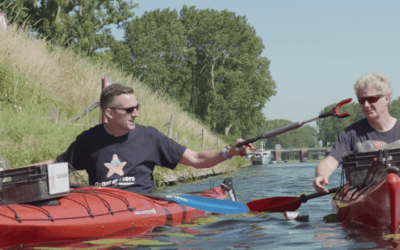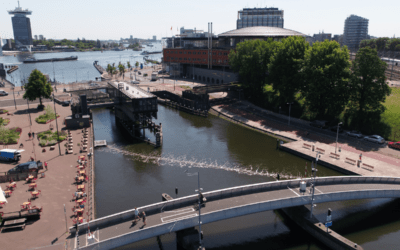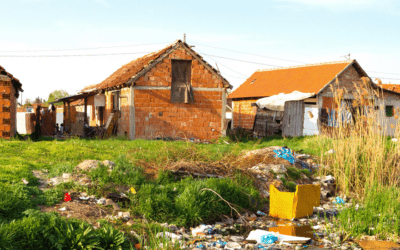By Anne Marieke Eveleens
When we think of plastic pollution in water, we often associate it with ‘the Plastic Soup’ in the ocean. But have you heard of the plastic problem in our local rivers? New research suggests plastics can stay in waterways for decades, causing lasting harm to the environment and our health. Let’s talk about why the plastic soup in rivers deserves our attention.
Plastic leaks into the environment and turns into pollution, both on land and in water. This leakage happens throughout the plastic’s entire lifecycle. When plastic enters waterways, the resulting problem becomes twofold: Rivers and canals are found to not only transport plastic pollution to the ocean – contributing to plastic soup(s) – but also act as plastic reservoirs, trapping plastic where it can remain for years[1].
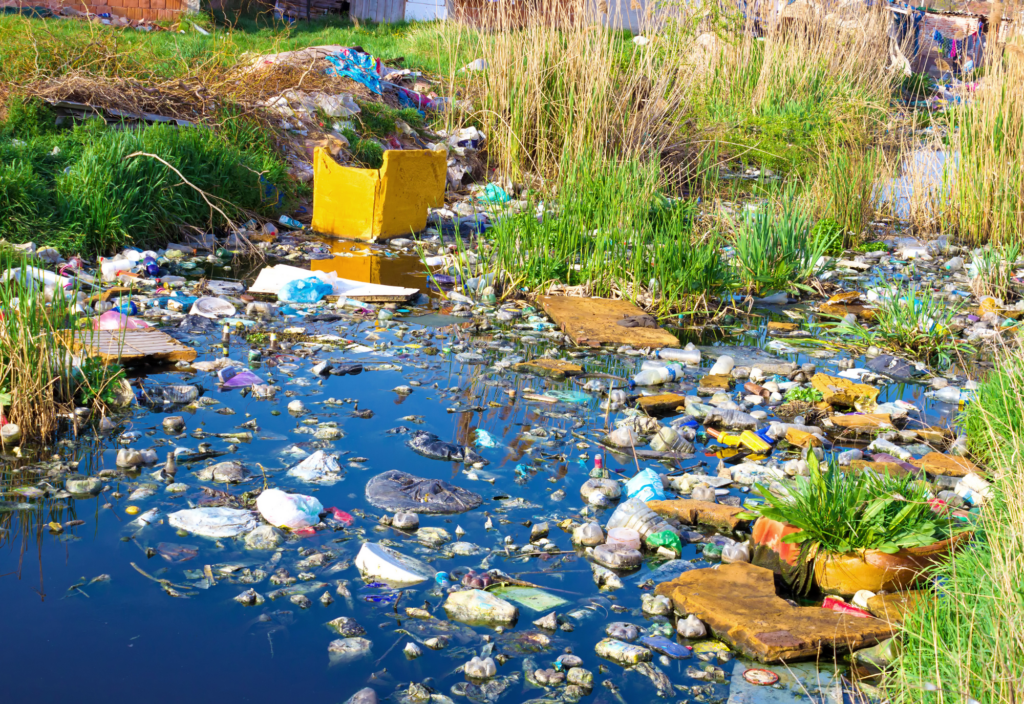
Research on river plastic pollution
The topic of plastic pollution in the ocean has gotten increasing attention over the last few years. However, research on plastic pollution in rivers remains a little-known subject. This could be in part due to plastic pollution still being an emerging field of research. Most dominant research on plastic pollution focused on plastic in the marine environment, and more specifically on estimating plastic emissions into the ocean and seas.[2][3][4]
This has left us with a knowledge gap about river plastic pollution[5], and an underestimation of its threats[6]. Only recently we have seen a shift towards understanding river plastic pollution before it reaches the ocean[7][8]. Bridging these research gaps is important to fully grasp the extent of the plastic pollution crisis. Researching the movement of plastic in rivers is one of the essential topics that will eventually help prevent plastic leakage, and support clean-up technologies in effectively removing plastic pollution.
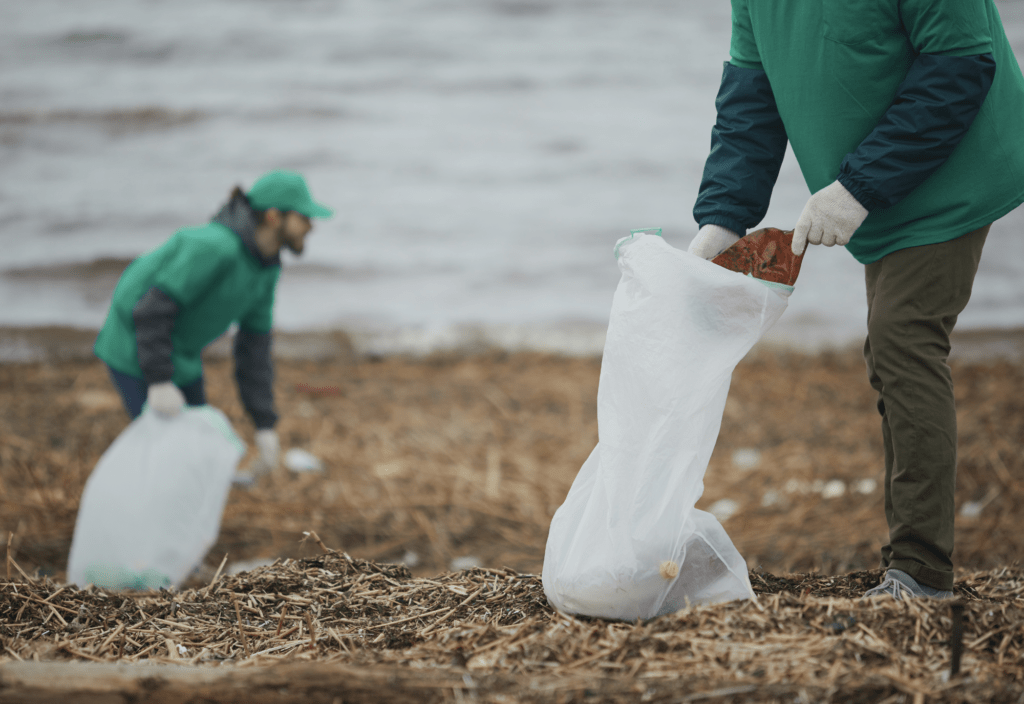
While more research is still needed on river plastic pollution, recent discoveries suggest that not all plastics in rivers flow into the ocean[9].
Researchers explain the theory that rivers function as plastic reservoirs. They found that “only a small fraction” of plastic found in river systems is emitted to the ocean, while “the vast majority can be retained for years, decades, and potentially centuries”[10].
To explain their hypothesis, the researchers observed and categorised six main retention mechanisms in river systems. Plastic can be retained at or in:
- riverbanks and floodplains
- plants
- riverbed sediments
- infrastructure (like dams or ports)
- lakes
- and estuaries
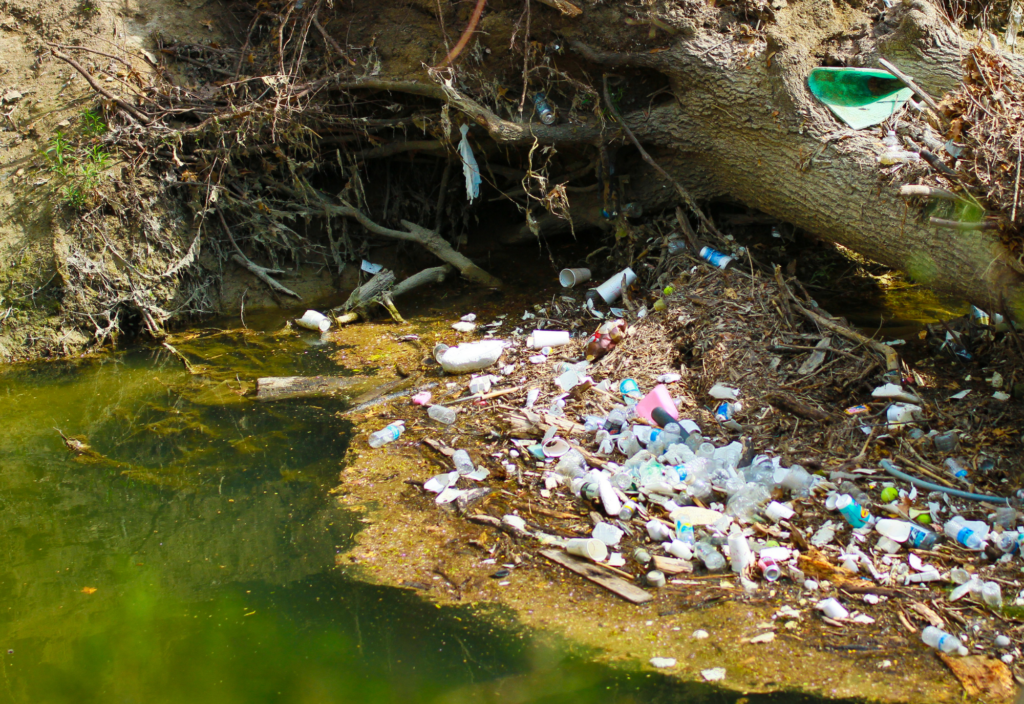
The researchers claim that even if no more plastic leaks into the environment as of today, “the plastics retained within river systems will continue to have negative impacts and break down into smaller particles.” At the same time, river plastic “functions as a potential source of marine plastic pollution for the decades and centuries to come”.[11]
Pinning down the exact route that a piece of plastic follows when entering a river, is not yet within reach. To further expand our shared knowledge on the movement of plastic pollution in rivers, the researchers also advocate for continued large-scale, holistic studies. They propose a focus on doing more experiments using GPS-tracked plastic, using remote sensing for data collection (such as through satellite imagery), and promoting citizen science apps[12].
What happens when plastics stay in rivers?
It’s hard to estimate what will happen to a specific piece of plastic pollution as different types of plastic react differently to environmental factors like sun exposure and river currents. Depending on its type, some plastic might stay intact for years or some may break down into smaller pieces[13]. Plastics can take anywhere from 20 to 500 years to decompose, and even then, they never fully disappear; they just get smaller and smaller and turn into microplastics[14]. When plastics enter the water, many different problems can arise:
- Entanglement, ingestion and strangulation of plastics by animals[15]
- Fragmentation into smaller plastic pieces, creating microplastics and nanoplastics[16]
- Spread of harmful toxins that latch onto the plastics[17]
- Microplastics ending up in the river sedimentation[18]
Cleaning up rivers is essential because the longer plastics stay in rivers, the more species they interact with, which can potentially lead to more negative impacts on ecosystems[19] and even on the human food chain[20].
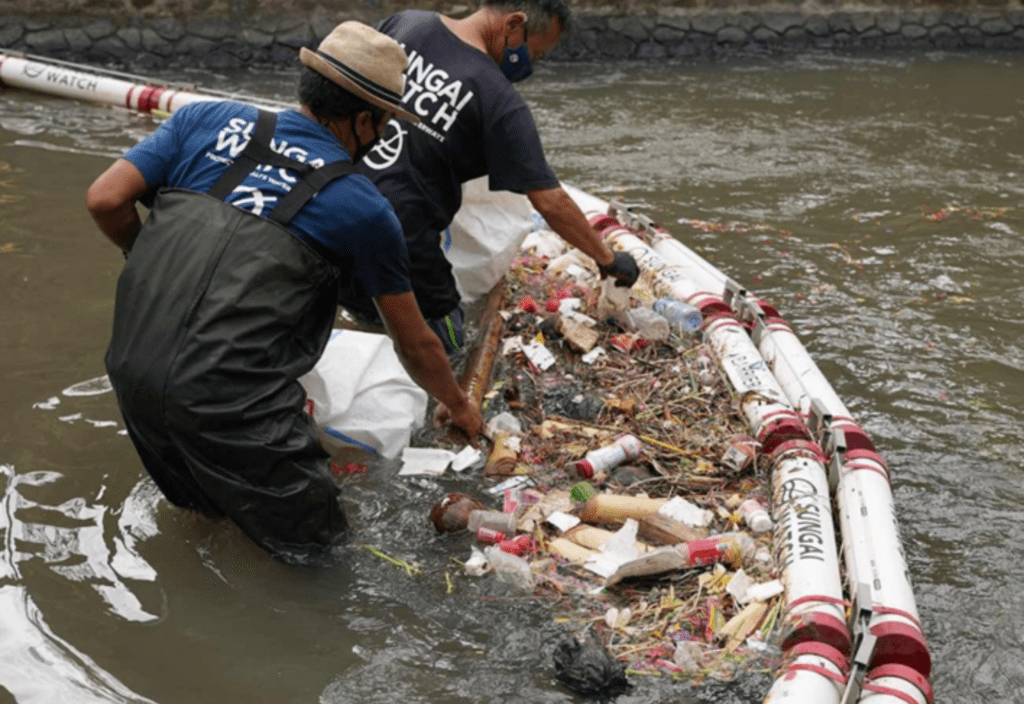
How can we clean rivers?
The different scenarios for what happens to the plastic once it enters the water, make it a challenge to effectively clean up. Because all rivers are different, there is no one-size-fits-all solution to clean them from plastic pollution. To successfully clean waterways, we need a variety of solutions at work.
Currently, many innovative technologies are cleaning up plastic pollution in rivers, for example, Interceptors from The Ocean Cleanup, Barriers from Sungai Watch, Seabins from Seabin, and our bubble curtain technology: the Bubble Barrier.
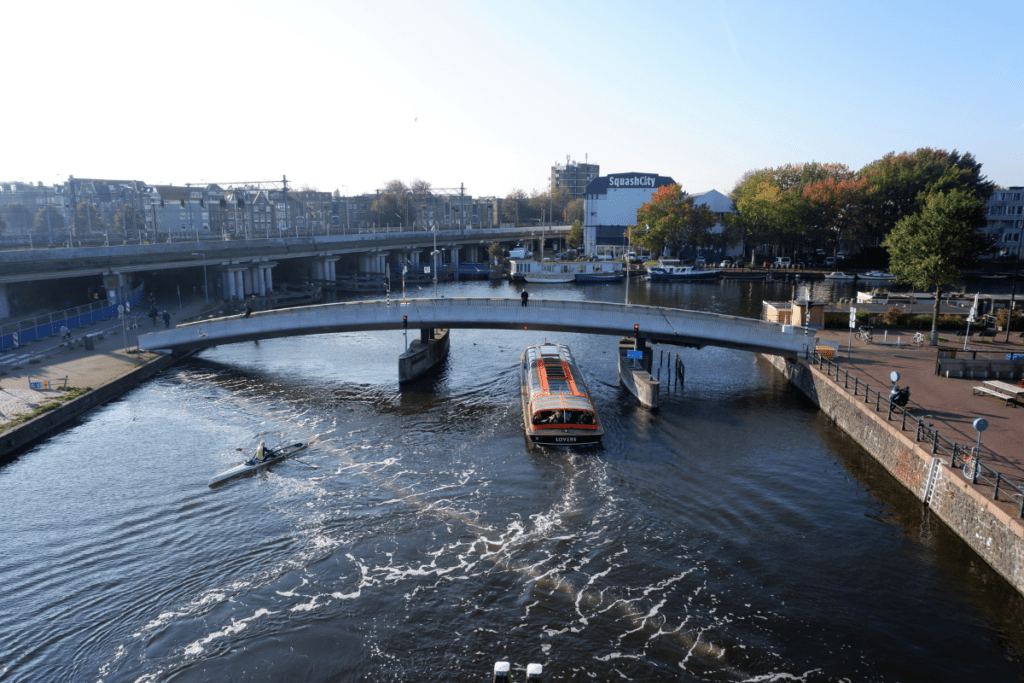
Closing the tap on plastic
Clean-up technologies play an important part in cleaning legacy plastics – plastics that are currently polluting environments – in rivers. The science is clear that rivers need to be cleaned from plastic sooner rather than later to prevent more damage. But if we don’t take drastic steps in the whole lifecycle of plastic, no amount of innovation will be enough to tackle the plastic pollution crisis. Most importantly, we need to seriously reduce global plastic production. Next to cutting production, ambitious international policy will allow us to work on closing the plastic tap while cleaning the plastic that is polluting our environment today.

Author
Anne Marieke Eveleens
Anne Marieke is Co-Founder & Chief Scientific Officer at The Great Bubble Barrier. She holds an M.Sc. in Neurobiology and has extensive experience applying her scientific background to interdisciplinary challenges bridging science & society.
Editors
Judith de Waard
Teagan Intaralib Prawmanee
References
[1] van Emmerik, T., Tramoy, R., van Calcar, C., Alligant, S., Treilles, R., Tassin, B., & Gasperi, J. (2021). Rivers as plastic reservoirs. Frontiers in Water, 3, 786936. https://doi.org/10.3389/frwa.2021.786936
[2] Jambeck, J. R., Geyer, R., Wilcox, C., Siegler, T. R., Perryman, M., Andrady, A., Narayan, R., & Law, K. L. (2015). Plastic waste inputs from land into the ocean. Science, 347(6223), 768-771. https://doi.org/10.1126/science.1260352
[3] Lebreton, L. C., Van der Zwet, J., Damsteeg, J. W., Slat, B., Andrady, A., & Reisser, J. (2017). River plastic emissions to the world’s oceans. Nature Communications, 8(1), 15611. https://doi.org/10.1038/ncomms15611
[4] Meijer, L. J., van Emmerik, T., van der Ent, R., Schmidt, C., & Lebreton, L. (2021). More than 1000 rivers account for 80% of global riverine plastic emissions into the ocean. Science Advances, 7(18), eaaz5803. https://doi.org/10.1126/sciadv.aaz5803
[5] Blettler, M. C., Abrial, E., Khan, F. R., Sivri, N., & Espinola, L. A. (2018). Freshwater plastic pollution: Recognizing research biases and identifying knowledge gaps. Water Research, 143, 416-424. https://doi.org/10.1016/j.watres.2018.06.015
[6] Blettler, M. C., & Wantzen, K. M. (2019). Threats underestimated in freshwater plastic pollution: Mini-review. Water, Air, & Soil Pollution, 230(7), 174. https://doi.org/10.1007/s11270-019-4220-z
[7] van Emmerik, T., & Schwarz, A. (2019). Plastic debris in rivers. WIREs Water, 7(1), e1398. https://doi.org/10.1002/wat2.1398
[8] Vaid, P., Sarma, K., & Gupta, A. K. (2021). Microplastic pollution in aquatic environments with special emphasis on riverine systems: Current understanding and way forward. Journal of Environmental Management, 297, 113354. https://doi.org/10.1016/j.jenvman.2021.113354
[9] van Emmerik, T., Tramoy, R., van Calcar, C., Alligant, S., Treilles, R., Tassin, B., & Gasperi, J. (2021). Rivers as plastic reservoirs. Frontiers in Water, 3, 786936. https://doi.org/10.3389/frwa.2021.786936
[10] Ibid.
[11] Ibid.
[12] van Emmerik, T., Vriend, P., & Copius Peereboom, E. (2022). Roadmap for long-term macroplastic monitoring in rivers. Frontiers in Environmental Science, 9, 802245. https://doi.org/10.3389/fenvs.2021.802245
[13] Zhang, K., Hamidian, A. H., Tubić, A., Zhang, Y., Fang, J. K., Wu, C., & Lam, P. K. (2021). Understanding plastic degradation and microplastic formation in the environment: A review. Environmental Pollution, 274, 116554. https://doi.org/10.1016/j.envpol.2021.116554
[14] United Nations Environment Programme. (2021). In Images: Plastic is Forever. United Nations.
[15] Blettler, M. C., & Wantzen, K. M. (2019). Threats underestimated in freshwater plastic pollution: Mini-review. Water, Air, & Soil Pollution, 230(7), 174. https://doi.org/10.1007/s11270-019-4220-z
[16] Liro, M., Zielonka, A., & van Emmerik, T. (2023). Macroplastic fragmentation in rivers. Environment International, 173, 107823. https://doi.org/10.1016/j.envint.2023.107823
[17] Engler, R. E. (2012). The complex interaction between marine debris and toxic chemicals in the ocean. Environmental Science & Technology, 46(22), 12302-12315. https://doi.org/10.1021/es3027105
[18] Ghinassi, M., Lazzarotto, A., Rossi, V., Daddi, T., & Cantasano, N. (2023). Mechanisms of microplastics trapping in river sediments: Insights from the Arno river. Science of The Total Environment, 858, 159757. https://doi.org/10.1016/j.scitotenv.2022.159757
[19] van Emmerik, T., Tramoy, R., van Calcar, C., Alligant, S., Treilles, R., Tassin, B., & Gasperi, J. (2021). Rivers as plastic reservoirs. Frontiers in Water, 3, 786936. https://doi.org/10.3389/frwa.2021.786936
[20] Waring, R. H., Harris, R. M., & Mitchell, S. C. (2018). Plastic contamination of the food chain: A threat to human health? Maturitas, 115, 64-68. https://doi.org/10.1016/j.maturitas.2018.06.010

